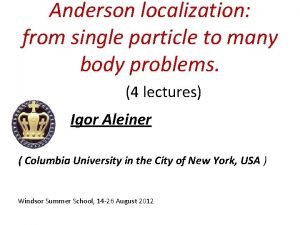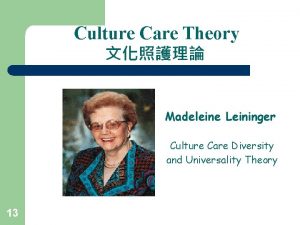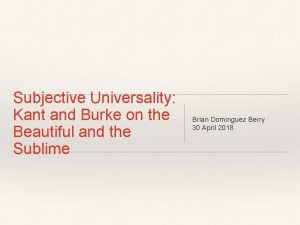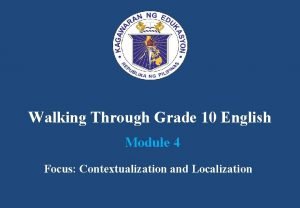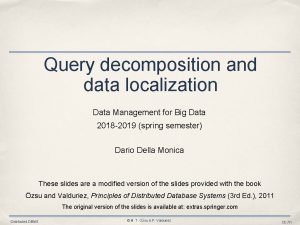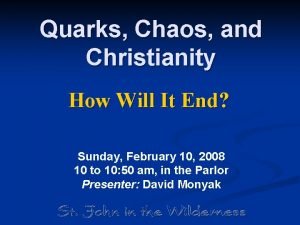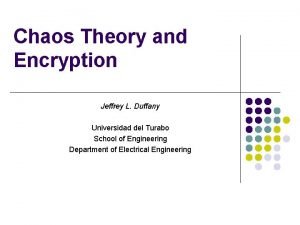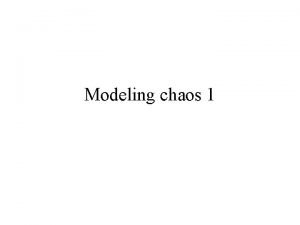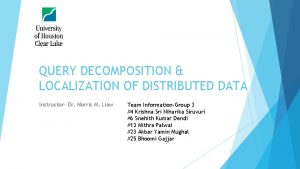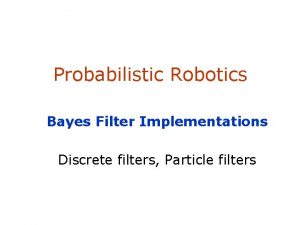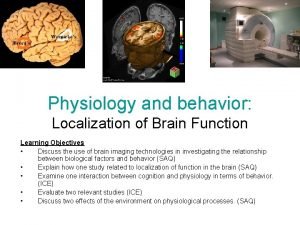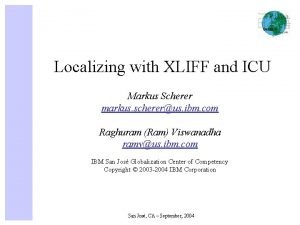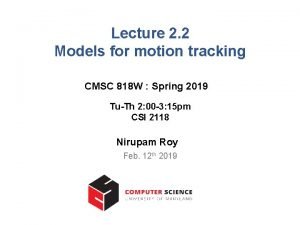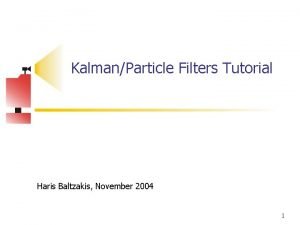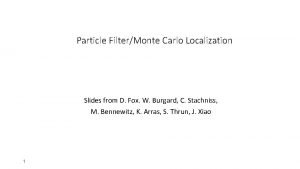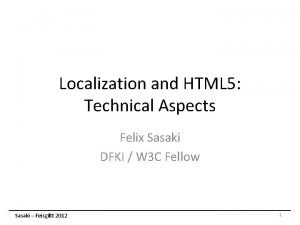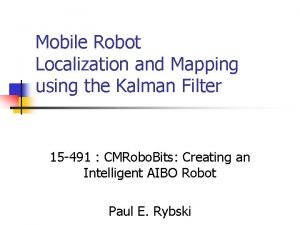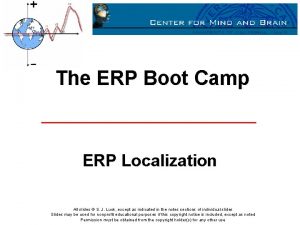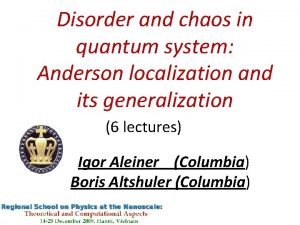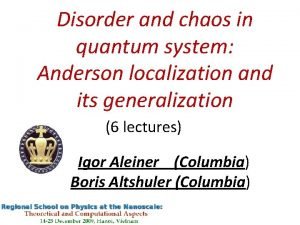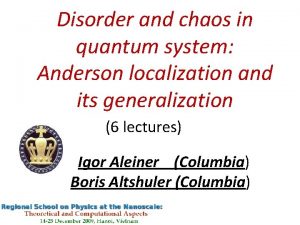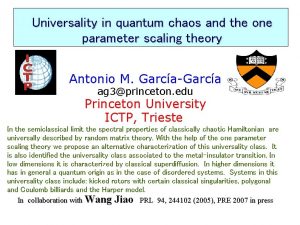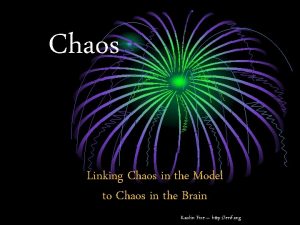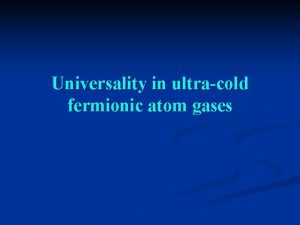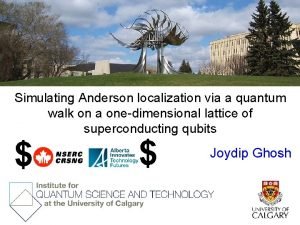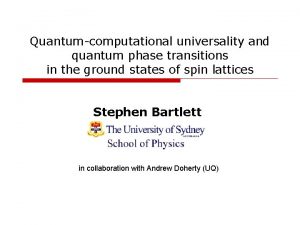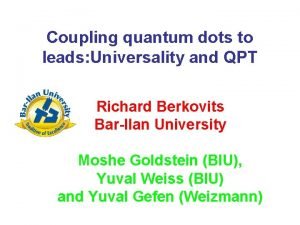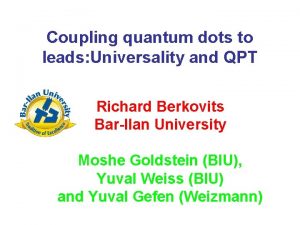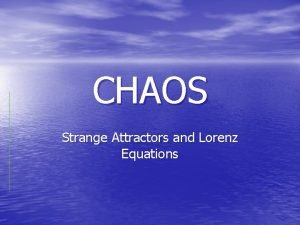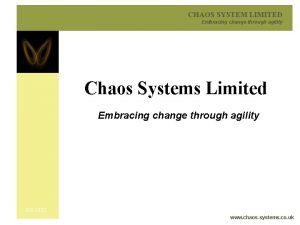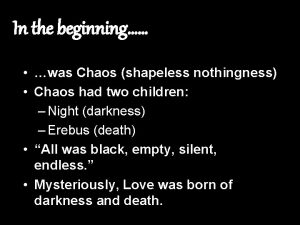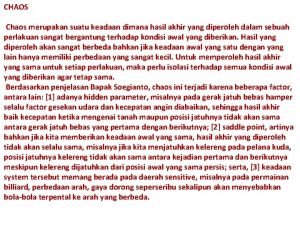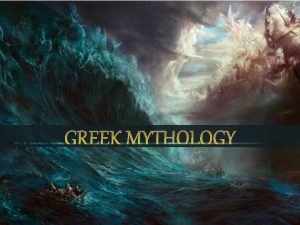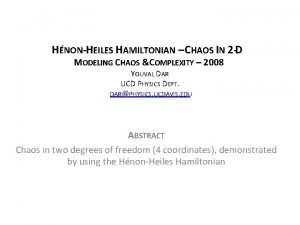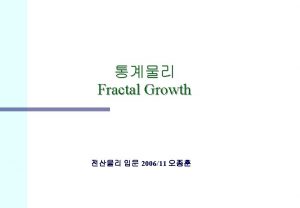Universality in quantum chaos Anderson localization and the
































- Slides: 32

Universality in quantum chaos, Anderson localization and the one parameter scaling theory Antonio M. García-García ag 3@princeton. edu Princeton University ICTP, Trieste In the semiclassical limit the spectral properties of classically chaotic Hamiltonian are universally described by random matrix theory. With the help of the one parameter scaling theory we propose an alternative characterization of this universality class. It is also identified the universality class associated to the metal-insulator transition. In low dimensions it is characterized by classical superdiffusion. In higher dimensions it has in general a quantum origin as in the case of disordered systems. Systems in this universality class include: kicked rotors with certain classical singularities, polygonal and Coulomb billiards and the Harper model. In collaboration with Wang Jiao, NUS, Singapore, PRL 94, 244102 (2005), PRE, 73, 374167 (2006).

Outline: 0. What is this talk about? 0. 1 Why are these issues interesting/relevant? 1. Introduction to random matrix theory 2. Introduction to theory of disordered systems 2. 1 Localization and universality in disordered systems 2. 2 The one parameter scaling theory 3. Introduction to quantum chaos 3. 1 Universality in QC and the BGS conjecture 4. My research: One parameter scaling theory in QC 4. 1 Limits of applicability of the BGS conjecture 4. 2 Metal-Insulator transition in quantum chaos

(Simple) Quantum mechanics Schrödinger equation + generic V(r) Quantum coherence beyond textbooks Impact of classical chaos in quantum mechanics ? Quantum mechanics in a random potential Quantum Chaos Disordered systems 1. Semiclassical techniques. 1. Powerful analytical techniques. 2. BGS conjecture. 2. Ensemble average. Relevant for: 3. Anderson localization. 1. Quantum classical transition. 2. Nano-Meso physics. Quantum engineering. 3. Systems with interactions for which the exact Schrödinger equation cannot be solved.

What information (if any) can I get from a “bunch” of energy levels? This question was first raised in the context of nuclear physics in the 50‘s High energy nuclear excitations -Shell model does not work -Excitations seem to have no pattern P(s) -Wigner carried out a statistical analysis of these excitations. s - Surprisingly, P(s) and other spectral correlator are universal and well described by random matrix theory (GOE).

Random Matrix Theory: Random matrix theory describes the eigenvalue correlations of a matrix whose entries are random real/complex/quaternions numbers with a (Gaussian) distribution. Signatures of a RM spectrum (Wigner-Dyson): 1. Level Repulsion 2. Spectral Rigidity = 1, 2, 4 for real, complex, quaternions Signatures of an uncorrelated spectrum (Poisson) : P(s) s In both cases spectral correlations are UNIVERSAL, namely, independent of the chosen distribution. The only scale is the mean level spacing .

Two natural questions arise: 1. Why are the high energy excitations of nuclei well described by random matrix theory (RMT)? 2. Are there other physical systems whose spectral correlations are well described by RMT? Answers: 1. It was claimed that the reason is the many body “complex” nature of the problem. It is not yet fully understood!. 2. 1 Quantum chaos (’ 84): Bohigas-Giannoni-Schmit conjecture. Classical chaos RMT 2. 2 Disordered systems(’ 84): RMT correlations for weak disorder and d > 2. Supersymmetry method. Microscopic justification. Efetov 2. 3 More recent applications: Quantum Gravity (Amborjn), QCD, description of networks (www).

A few words about disordered systems: The theory of disordered systems studies a quantum particle in a random potential. Questions: Answers: 1. How do quantum effects modify the transport properties of a particle whose classical motion is diffusive? . a) Many of the main results of the field are already included in the original paper by Anderson 1957!! b) Weak localization corrections are well understood. Lee, Altshuler. Dclast Dquant c) A really quantitative theory of strong localization is still missing but: 1. Self-consistent theory from the insulator side, valid only for d >>1. No interference. Abu-Chakra, Anderson, 73 <x 2> Dquanta t a=? Dquan=f(d, W)? 2. Self-consistent theory from the metallic side, valid only for d ~ 2. No tunneling. Vollhardt and Wolffle, ’ 82 3 One parameter scaling theory(1980). Gang of four. Correct but qualitative

Your intuition about localization Ea V(x) Eb 0 Ec X Assume that V(x) is a truly disordered potential. Question: For any of the energies above, will the classical motion be strongly affected by quantum effects?

Localisation according to the one parameter scaling theory Insulator (eigenstates localised) Anderson transition When? For d < 3 or, (or d > 3 for strong disorder). Why? Caused by destructuve interference. How? Diffusion stops, Poisson statistics and discrete spectrum. Metal (eigenstates delocalised) When? d > 2 and weak disorder, eigenstates delocalized. Why? Interference effects are small. Kramer, et al. How? Diffusion weakly slowed down, Wigner-Dyson statistics and continous spectrum. Anderson transition For d > 2 there is a critical density of impurities such that a metalinsulator transition occurs. Sridhar, et. al Insulator Metal

Energy scales in a disordered system 1. Mean level spacing: 2. Thouless energy: t. T(L) is the typical (classical) travel time through a system of size L Dimensionless Thouless conductance Diffusive motion without quantum corrections Metal Insulator Wigner-Dyson Poisson

Scaling theory of localization The change in the conductance with the system size only depends on the conductance itself Beta function is universal but it depends on the global symmetries of the system Quantum Weak localization In 1 D and 2 D localization for any disorder In 3 D a metal insulator transition at gc , (gc) = 0

0 Altshuler, Introduction to mesoscopic physics

What is quantum chaos? 1. Quantum chaos studies the quantum properties of systems whose classical motion is chaotic. 2. More generally it studies the impact on the quantum dynamics of the underlying deterministic classical motion, chaotic or not. Bohigas-Giannoni-Schmit conjecture Classical chaos Wigner-Dyson Energy is the only integral of motion Momentum is not a good quantum number Eigenfunctions delocalized in momentum space

Gutzwiller-Berry-Tabor conjecture Integrable classical motion Poisson statistics (Insulator) Integrability in d dimensions P(s) d canonical momenta are conserved s Momentum is a good quantum number System is localized in momentum space Poisson statistics is also related to localisation but in momentum space

Universality and its exceptions Bohigas-Giannoni-Schmit conjecture Exceptions: 1. Kicked systems Classical <p 2> Quantum t 2. Harper model 3. Arithmetic billiard Dynamical localization in momentum space

Questions: 1. Are these exceptions relevant? 2. Are there systems not classically chaotic but still described by the Wigner-Dyson? 3. Are there other universality class in quantum chaos? How many? 4. Is localization relevant in quantum chaos?

Random QUANTUM Delocalized wavefunctions Wigner-Dyson Localized wavefunctions Poisson Anderson transition Critical Statistics Deterministic Chaotic motion Only? Integrable motion ? ? ? ?

Main point of this talk Adapt the one parameter scaling theory in quantum chaos in order to: 1. Determine the universality class in quantum chaos related to the metal-insulator transition. 2. Determine the class of systems in which Wigner. Dyson statistics applies. 3. Determine whethere are more universality class in quantum chaos.

How to apply scaling theory to quantum chaos? 1. Only for classical systems with an homogeneous phase space. Not mixed systems. 2. Express the Hamiltonian in a finite momentum basis and study the dependence of observables with the basis size N. 3. For each system one has to map the quantum chaos problem onto an appropriate basis. For billiards, kicked rotors and quantum maps this is straightforward.

Scaling theory and anomalous diffusion de is related to the fractal dimension of the spectrum. The average is over initial conditions and/or ensemble Lapidus, fractal billiards Universality Wigner-Dyson Poisson (g) > 0 (g) < 0 weak localization? Two routes to the Anderson transition 1. Semiclassical origin 2. Induced by quantum effects

Wigner-Dyson statistics in non-random systems 1. Typical time needed to reach the “boundary” (in real or momentum space) of the system. Symmetries important. Not for mixed systems. In billiards it is just the ballistic travel time. In kicked rotors and quantum maps it is the time needed to explore a fixed basis. In billiards with some (Coulomb) potential inside one can obtain this time by mapping the billiard onto an Anderson model (Levitov, Altshuler, 97). 2. Use the Heisenberg relation to estimate the Thouless energy and the dimensionless conductance g(N) as a function of the system size N (in momentum or position). Condition: Wigner-Dyson statistics applies

Anderson transition in non-random systems Conditions: 1. Classical phase space must be homogeneous. 2. Quantum power-law localization. 3. Examples: 1 D: =1, de=1/2, Harper model, interval exchange maps (Bogomolny) =2, de=1, Kicked rotor with classical singularities (AGG, Wang. Jiao). 2 D: =1, de=1, Coulomb billiard (Altshuler, Levitov). 3 D: =2/3, de=1, 3 D Kicked rotor at critical coupling.

1 D kicked rotor with singularities Classical Motion Normal diffusion Anomalous Diffusion Quantum Evolution 1. Quantum anomalous diffusion 2. No dynamical localization for <0

1. >0 Localization Poisson 2. <0 Delocalization Wigner-Dyson 3. =0 Anderson tran. Critical statistics AGG, Wang Jjiao, PRL 2005 Anderson transition 1. log and step singularities 2. Multifractality and Critical statistics. Results are stable under perturbations and sensitive to the removal of the singularity

Analytical approach: From the kicked rotor to the 1 D Anderson model with long-range hopping Fishman, Grempel and Prange method: Dynamical localization in the kicked rotor is 'demonstrated' by mapping it onto a 1 D Anderson model with short-range interaction. Kicked rotor Anderson Model Tm pseudo random The associated Anderson model has long-range hopping depending on the nature of the non-analyticity: Explicit analytical results are possible, Fyodorov and Mirlin

Signatures of a metal-insulator transition 1. Scale invariance of the spectral correlations. A finite size scaling analysis is then carried out to determine the transition point. Skolovski, Shapiro, Altshuler var 2. 3. Eigenstates are multifractals. Mobility edge Anderson transition



V(x)= log|x| =15 =8 =4 =2 Spectral χ =0. 026 χ =0. 057 χ=0. 13 χ=0. 30 Multifractal D 2= 0. 95 D 2= 0. 89 D 2 ~ 1 – 1/ D 2= 0. 72 D 2= 0. 5 Summary of properties 1. Scale Invariant Spectrum 2. Level repulsion 3. Linear (slope < 1), 3 ~ /15 4. Multifractal wavefunctions 5. Quantum anomalous diffusion ANDERSON TRANSITON IN QUANTUM CHAOS Ketzmerick, Geisel, Huckestein

3 D kicked rotator In 3 D, for =2/3 Finite size scaling analysis shows there is a transition a MIT at kc ~ 3. 3

Experiments and 3 D Anderson transition Our findings may be used to test experimentally the Anderson transition by using ultracold atoms techniques. One places a dilute sample of ultracold Na/Cs in a periodic step-like standing wave which is pulsed in time to approximate a delta function the atom momentum distribution is measured. The classical singularity cannot be reproduced in the lab. However (AGG, W Jiao, PRA 2006) an approximate singularity will still show typical features of a metal insulator transition.

CONCLUSIONS 1. One parameter scaling theory is a valuable tool in the understanding of universal features of the quantum motion. 2. Wigner Dyson statistics is related to classical motion such that 3. The Anderson transition in quantum chaos is related to 4. Experimental verification of the Anderson transition is possible with ultracold atoms techniques.
 Anderson localization lecture notes
Anderson localization lecture notes Culturally congruent care
Culturally congruent care Subjective universality
Subjective universality Classical physics
Classical physics Quantum physics vs mechanics
Quantum physics vs mechanics English module grade 10
English module grade 10 Query decomposition in distributed database
Query decomposition in distributed database Contextualization and localization
Contextualization and localization Localized curriculum sample
Localized curriculum sample Big crunch
Big crunch Chaos theory and cryptology
Chaos theory and cryptology Fractals and chaos
Fractals and chaos Voice localization using nearby wall reflections
Voice localization using nearby wall reflections Neural network ib psychology
Neural network ib psychology Localisation of distributed data
Localisation of distributed data Markov localization
Markov localization Localization of behavior
Localization of behavior Tube shift technique
Tube shift technique Monte carlo localization for mobile robots
Monte carlo localization for mobile robots Icu localization
Icu localization Basic concepts of probability
Basic concepts of probability Markov localization
Markov localization Markov localization
Markov localization Localization in mobile computing
Localization in mobile computing Games language
Games language Markov localization
Markov localization Monte carlo localization python
Monte carlo localization python Localization in html5
Localization in html5 Localization industry standards association
Localization industry standards association Dnn roadmap
Dnn roadmap Dynamics nav localization
Dynamics nav localization Mobile robot localization
Mobile robot localization Erp localization
Erp localization
